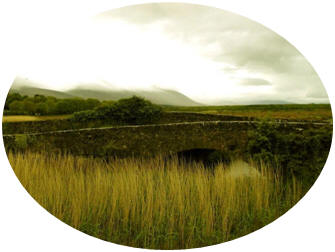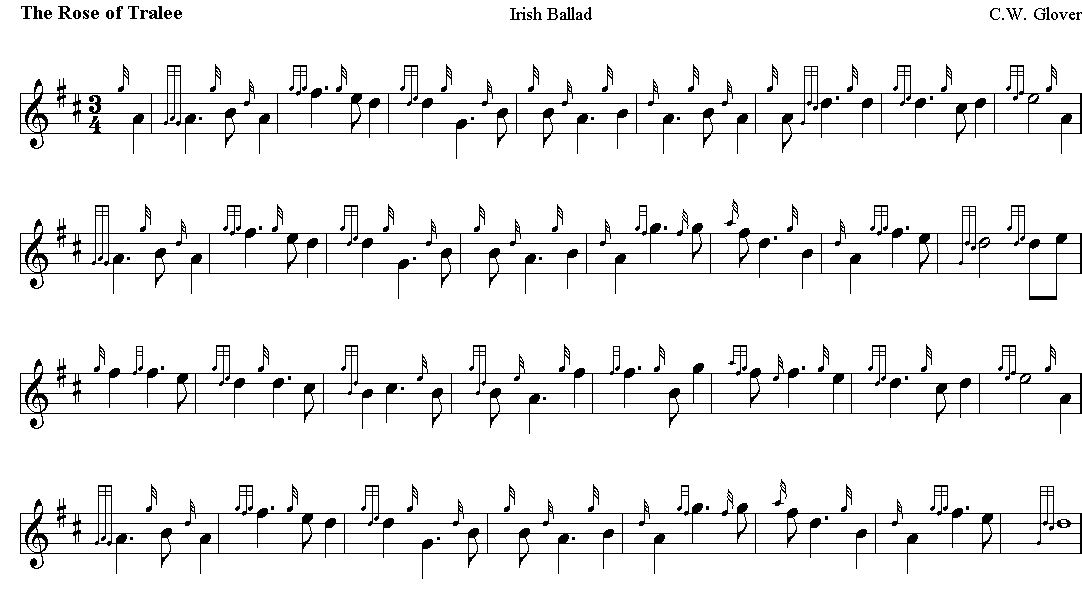
Best viewed in
Internet Explorer
Music (PDF)
Music (BMW)
Back to

Updated
05/24/2013 |

The Rose of Tralee
The Story of the Rose of Tralee Mary O'Connor lived in the middle of
Tralee town, in Brogue Lane, which took its name from the broguemakers
(or shoemakers) who lived and worked there. Mary lived in a thatched
cabin with her parents, sisters Brigid and Ellen and younger brother
Willie. Her father was a broguemaker, and her mother worked as a
dairymaid. Mary was very beautiful; she had long dark hair and soft,
shining eyes.
Her status as the daughter of a broguemaker and dairymaid meant Mary was
destined for work as a maid or house-help. When she was 17 she secured
employment as a kitchen maid for the Mulchinock household in Tralee.
The Mulchinocks were a wealthy family of merchants who owned a wool and
linen draper's shop on the site of what is now Heaton's department store
in Tralee.
Michael Mulchinock had married Margaret McCann and they lived in the
grand Mulchinock house, West Villa. The family owned a considerable
amount of land around the house and the neighborhood, as well as
property in town. They had servants, coachmen, gardeners and farmhands.
Michael died of a fever in 1828, so Margaret Mulchinock was head of the
household when Mary O'Connor started working in the kitchens of West
Villa. Also living in the house were Margaret's sons William Pembroke,
Edward, Henry and her married daughter Maria.
Mary O'Connor was delighted to be given employment at West Villa, and
soon Margaret's daughter, Maria, seeing that Mary was intelligent and
kind to her children asked her to be maid to her daughters Anne and
Margaret.
Margaret Mulchinock's sons had grown to be young men and William was
becoming a dreamer. In the eyes of his family he was good-for-nothing,
and even worse: a poet.
In November 1840 Henry, William's younger brother, died. William was
inconsolable as he was closer to William than his more practical brother
Edward. He wrote a poem about his feelings:
For him of the fair young brow I weep,
Who takes in the churchyard now his sleep;
For he was the star above sun-bright,
That tinged with the light of love my night.
It wasn't long before William met his sister's new nursemaid. As soon as
he saw Mary he was transfixed by her eyes, her grace, her long dark hair
and delicate skin.
Mary and William began to meet each other every day by the well in the
grounds of West Villa, that looked out over the sea and mountains.
Sometimes they walked down Lover's Lane or up to Clahane to dance.
One night beneath the pale, silvery moon William asked Mary to marry
him. However, William's family disapproved of him seeing Mary, the
broguemaker's daughter who lived in a small peasant house in the middle
of town. Whilst Mary loved William, she knew that their union could
never be, as it would force him to turn his back on his family and he
would begin to regret the day he'd ever met her. She declined his offer
of marriage.
William refused to give up. He wrote a song for Mary to try and convince
her otherwise.
The pale moon was rising above the green mountains,
The sun was declining beneath the blue sea,
When I strayed with my love by the pure crystal fountain,
That stands in the beautiful Vale of Tralee.
She was lovely and fair as the rose of the summer,
Yet 'twas not her beauty alone that won me.
Oh no, 'twas the truth in her eyes ever dawning
That made me love Mary, the Rose of Tralee.
But Mary still refused to marry him.
The next evening, after attending a political rally in town, William
went to visit Mary at West Villa and gave her a ring which he placed on
her finger. Suddenly the door burst open and a friend of William's
rushed in to inform him that William had been accused of the murder of a
man at the rally. Two men had got into a fight and as leader of one of
the rebel groups challenging the upcoming election, William had been
held responsible. William's friend informed him there was a warrant out
for his arrest and a reward of 100 gold sovereigns for finding him. He
was told to make for Barrow Harbour and get on a wine ship that was
leaving that night. William kissed Mary goodbye and told her he would
return soon.
William made his way to India where he worked as a war correspondent.
Here he met an officer from Limerick who asked William what had bought
him to India. When William told him the officer said he would use his
influence to get William returned to Ireland, and to Tralee, a free man.
So in 1849, some six years after leaving Tralee, William returned. He
stopped off at The Kings Arms in Rock Street for a drink before planning
to visit Mary in nearby Brogue Lane. The landlord began to draw the
curtains to mark the passing of a funeral coming down the street. On
enquiring who the funeral was for, William was told it was for a local
girl from Brogue Lane, a lovely and fair young woman named Mary O'Connor
- the Rose of Tralee.
William was devastated and his heart broken. There was nothing left for
him but to visit Mary's grave on the outskirts of town. The famine was
at its height in Ireland at this time and most of the country's eight
million inhabitants were trying to survive on a diet of potatoes alone.
William never got over Mary's death, and despite marrying and having
children with an old flame he refused to forget her.
William moved with his family to New York in 1849 but returned alone six
years later to Tralee and lived the rest of his life in Ashe Street. He
died in 1864 at the age of 44 and at his request was buried at the
graveyard in Clogherbrien next to his true love Mary, the Rose of
Tralee.
You can visit Mary O'Connor's grave at the graveyard in Clogherbrien by
taking the Fenit road out of Tralee and the graveyard is on the right
hand side.

|



